BMW 745li Sedan 2002 Owner's Manual
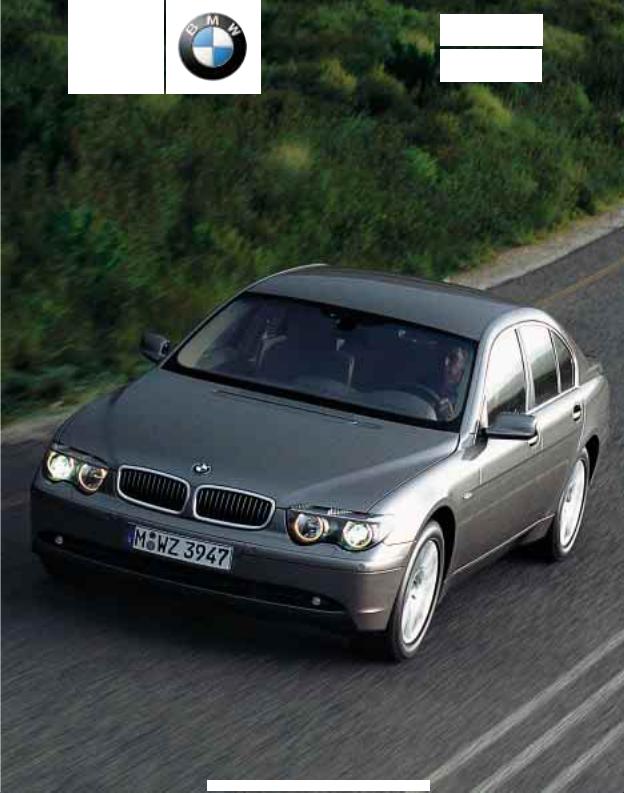
Owner's Manual for Vehicle

745i
745Li
Congratulations, and thank you for choosing a BMW.
Thorough familiarity with your vehicle will provide you with enhanced control and security when you drive it. We therefore have this request:
Please take the time to read this Owner's Manual and familiarize yourself with the information that we have compiled for you before starting off in your new vehicle. It contains important data and instructions intended to assist you in gaining maximum use and satisfaction from your BMW's unique range of technical features. The manual also contains information on maintenance designed to enhance operating safety and contribute to maintaining the value of your BMW throughout an extended service life.
This Owner's Manual should be considered a permanent part of this vehicle. It should stay with the vehicle when sold to provide the next owner with important operating, safety and maintenance information.
This manual is supplemented by a Service and Warranty Information Booklet for US models or a Warranty and Service Guide Booklet for Canadian models.
We recommend that you read this publication thoroughly.
Your BMW is covered by the following warranties:
–New Vehicle Limited Warranty
–Limited Rust Perforation Warranty
–Federal Emissions System Defect Warranty
–Federal Emissions Performance Warranty
–California Emission Control System Limited Warranty
Detailed information about these warranties is listed in the Service and Warranty Information Booklet for US models or in the Warranty and Service Guide Booklet for Canadian models.
We wish you an enjoyable driving experience.
BMW AG

Inhaltsverzeichnis
Contents
Notes
6Using this Owner's Manual
6Symbols used
7The individual vehicle
7Editorial notice
8For you own safety
9REPORTING SAFETY DEFECTS
Cockpit
12 Driver's side – Controls and displays
16Comfort and convenience – Controls and displays
18 Buttons in steering wheel
Control Center
19The concept
19Controller
19Control Display
20Symbols and lists
22Menus in Control Display
23Assistance window
Voice command
25 Voice command system
25 Voice commands
27 Notices
27 The notebook
29 Brief commands
Opening and closing
34Keys
35Central locking system
35 Opening and closing – from outside
37Opening and closing – from inside
38Doors
38 Luggage compartment lid
© 2001 Bayerische Motoren Werke Aktiengesellschaft
Munich, Germany
Reprints, in whole or part, approved exclusively with written permission of BMW AG, Munich.
Order No. 01 40 0 156 097 US X/2001
Printed in Germany
Printed on environmentally friendly paper (bleached without chlorine, suitable for recycling).
40 Luggage compartment
40 Alarm system
42Electric power windows
43Sliding/tilt sunroof
Adjustments
45 Correct sitting position
45 Seats
48 Head restraints
50Safety belts
50Heated seats
51Active seat ventilation
52Active seat
52Mirror
53Steering wheel adjustment
54Seat, mirror and steering wheel memory
55Airbags
57Transporting children safely
58LATCH child-restraint system
59Child-safety locks
59 Car Memory, Key Memory
Driving
61Ignition lock
62Starting the engine
62Switching off engine
62Parking brake
66Automatic transmission with L mode
69Automatic transmission with Steptronic
71Turn signal indicators/headlamp flasher
71 Wiper system
73 Washer fluid

73 Programmable cruise control
Everything under control
77Odometer, outside temperature display, clock
77Tachometer
78Service Interval Display
80Check Control
81Computer
86Changing settings
Technology for comfort, convenience and safety
88PDC Park Distance Control*
89Driving stability control/
DSC Dynamic Stability Control
91Driving stability control/ABS Antilock Brake System
91Dynamic Drive
92EDC Electronic Damping Control*
92RDC Tire Pressure Monitor*
94Self-leveling suspension*
94Adaptive brake lamp
Lamps
96Parking lamps/low beams
97Instrument lighting
97 High beams/standing lamps
97 Front fog lamps
97 Interior lamps
A congenial climate
99 Automatic climate control
105Rear air conditioner*
106Parked-car ventilation system
Practical interior accessories
108Universal Garage Door Opener*
109Sun blinds*
110Rear cooler*
110Glove compartment
111Storage compartments
112Beverage holders
112Ashtray, front
113Cigarette lighter, front
113Power socket
113Ashtray, rear
113Cigarette lighter, rear
113Center armrest
114Ski bag*
Things to remember when driving
118Break-in procedures
118General driving notes
119Brake system
120Cargo loading
120 Roof-mounted luggage rack*
Navigation
124Safety
124GPS
124Map CD
125Starting the navigation system
125Display in assistance window*
126Selection options
126 Destination entry
126 Manual entry of destination address
128Select the town or city and the street from the directory
128Map-guided destination selection
129Selecting destination in Information
129Selecting interesting destinations
130Recent destinations
130Destination list
130Route selection
131Starting the destination guidance system
132Displaying route
133Select new route
133Voice messages
134Terminate/interrupt active guidance
134Creating a directory
135Location
136Wordmatch principle
136 What to do if …
Sound system
140 Controls
140Care instructions
140To switch on/off
140Using with ignition off
141Volume adjustment
141Tone control
At a glance
Communications Entertainment Navigation Driving tips Controls
Reference Mobility

Inhaltsverzeichnis
Radio
143Select the frequency band
143Station selection
144Storing and retrieving a station
145Weather Band
CD Compact Disc
146Using the buttons to search for music tracks
147Searching for music tracks in the Control Display
CD changer
149Starting and stopping the CD changer
149Status displays
149Searching for music tracks in the Control Display
150Using the buttons to search for music tracks
MiniDisc MD
151Using the buttons to search for music tracks
152Searching for music tracks in the Control Display
Cassette
153Noise suppression
154Music track search
Using your mobile phone
158Safety notice
159Care instructions
159Operation
161Hands-free system
161To make SOS call
161Initial operation
162Getting started
162Telephone directory
163To select a number from the Top 8 list
164Redialing, including numbers not initially reached
164 Missed calls
Refueling
168Fuel filler door
169Fuel specifications
Wheels and tires
170Tire inflation pressure
171Tire condition
172Tire replacement
173Wheel and tire combinations
173 Special characteristics of winter tires
173 Snow chains
Under the hood
175Hood
176Engine compartment
176Engine oil
177Coolant
178Brake fluid
Maintenance
179 The BMW Maintenance System
179 Care
Rules and regulations
180 California Proposition 65 Warning
180 OBD connector
Replacing components
181 Onboard tool kit
181 Windshield wiper blades
181 Lamps and bulbs
183 Changing a tire
185Battery
186Fuses
Help – Giving and receiving
187Warning triangle
187First-aid kit
187Jump-starting
188Towing
Technical data
192Engine specifications
193Dimensions
194Weights
194 Capacities
Everything from A to Z
195 Contents

Reference |
|
Mobility |
|
Communications |
|
Entertainment |
|
Navigation |
|
Driving tips |
|
Controls |
|
At a glance |
|
|
|
|
|
|
|
|
|
|
|
|
|
|
|
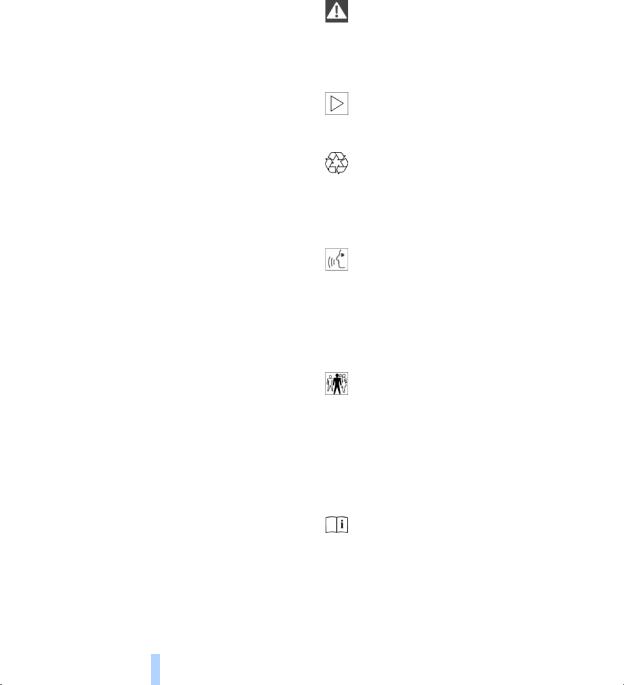
Notes
Notes
Using this Owner's Manual
In compiling this Owner's Manual we have made every effort to furnish you with a convenient reference source affording quick access to all the essentials. The fastest way to find detailed information on any specific subject is to turn to the comprehensive index at the back of the manual. For a brief initial overview, please refer to the first chapter.
Should the day come when you decide to sell your BMW, please remember to make certain that the new owner receives this manual; it is an important part of the vehicle.
If you have any additional questions, your BMW center will be glad to advise you.
Symbols used
Indicates precautions that must be followed precisely in order to avoid
the possibility of personal injury and serious damage to the vehicle.<
< Marks the end of a specific item of information.
Contains information that will assist you in gaining the optimum benefit from your vehicle and enable you to care
more effectively for your vehicle.<
Refers to measures that can be taken to help protect the environment.<
* Identifies special equipment, countyspecific equipment and optional extras.
"..." Identifies Control Display texts used to select individual functions.<
These sections contain information on using the voice command
system.<
>>...<< Verbal instructions to use with the voice command system. It is not necessary to say the words in parentheses.
>...< Identifies the answers generated by the voice command system.<
Identifies systems or components, which can either be activated or
adapted to suit an individual driver's requirements ("Car Memory", "Key Memory"). Refer to page 59.
Remember that activation and adjustments on some of these systems can only be performed at your BMW center.<
Symbols on vehicle components
Indicates that you should consult the relevant section of this Owner's
Manual for information on a particular part or assembly.
6

The individual vehicle
On purchasing your BMW, you have decided in favor of a model with individualized equipment and features. This Owner's Manual describes the entire array of options and equipment available with a specific BMW model.
Please bear in mind that the manual may contain information on accessories and equipment that you have not specified for your own vehicle. Sections describing options and special equipment are marked by asterisks * to assist you in identifying possible differences between the descriptions in this manual and your own vehicle's equipment.
Should your BMW be equipped with features or accessories not described in this manual, please consult the enclosed supplementary manual(s).
Editorial notice
BMW pursues a policy of continuous, ongoing development that is conceived to ensure that our vehicles continue to embody the highest quality and safety standards combined with advanced, state- of-the-art technology. For this reason, it is possible that the features described in this Owner's Manual could differ from those on your vehicle. Nor can errors and omissions be entirely ruled out. You are therefore asked to appreciate that no legal claims can be entertained on the basis of the data, illustrations or descriptions in this Owner's Manual.
7
At a glance
Communications Entertainment Navigation Driving tips Controls
Reference Mobility
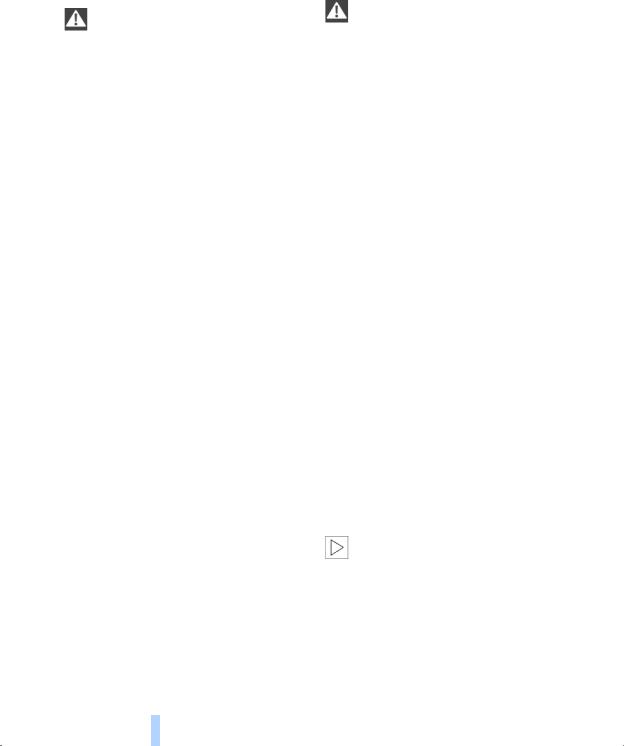
Notes
For you own safety
Use unleaded gasoline only. Fuels containing up to and including 10%
ethanol or other oxygenates with up to 2.8% oxygen by weight – that is, 15% MTBE or 3% methanol plus an equivalent amount of co-solvent – will not void the applicable warranties respecting defects in materials or workmanship. Field experience has indicated significant differences in fuel quality – volatility, composition, additives, etc. – among gasolines offered for sale in the United States and Canada. The use of poor quality fuels may result in driveability, starting and stalling problems especially under certain environmental conditions such as high ambient temperature and high altitude.
Should you encounter driveability problems which you suspect could be related to the fuel you are using, we recommend that you respond by switching to a recognized high-quality brand.
Failure to comply with these recommendations may result in unscheduled maintenance.
Follow the relevant safety rules when you are handling gasoline.<
Important safety information
For your own safety, use genuine parts and accessories approved by
BMW.
When you purchase accessories tested and approved by BMW and Original BMW Parts, you simultaneously acquire the assurance that they have been thoroughly tested by BMW to ensure optimum performance when installed on your vehicle. BMW warrants these parts to be free from defects in material and workmanship. BMW will not accept any liability for damage resulting from installation of parts and accessories not approved by BMW. BMW cannot test every product made by other manufacturers to verify if it can be used on a BMW safely and without risk to either the vehicle, its operation, or its occupants. Original BMW Parts, BMW Accessories and other products approved by BMW, together with professional advice on using these items, are available from all BMW centers.
Installation and operation of non-BMW approved accessories such as alarms, radios, amplifiers, radar detectors, wheels, suspension components, brake dust shields, telephones – including operation of any portable cellular phone from within the vehicle without using an externally mounted antenna – or transceiver equipment, for instance, CBs, walkie-talkie, ham radio or similar accessories, may cause extensive damage to the vehicle, compromise its safety, interfere with the vehicle's electrical system or affect the validity of the BMW Limited Warranty. See your BMW center for additional information.<
Maintenance, replacement, or repair of the emission control devices and systems may be performed by any automotive repair establishment or individual using
any certified automotive part.<
8

The following only applies to vehicles owned and operated in the US.
REPORTING SAFETY DEFECTS
If you believe that your vehicle has a defect which could cause a crash or could cause injury or death, you should immediately inform the National Highway Traffic Safety Administration (NHTSA) in addition to notifying BMW of North America, LLC, P.O. Box 1227, Westwood, New Jersey 076751227, Telephone (201) 307-4000.
If NHTSA receives similar complaints, it may open an investigation, and if it finds that a safety defect exists in a group of vehicles, it may order a recall and remedy campaign. However, NHTSA cannot become involved in individual problems between you, your dealer, or BMW of North America, LLC.
To contact NHTSA, you may either call the Auto Safety Hotline toll-free at 1-800-424- 9393 (or 366-0123 in Washington, D.C. area) or write to: NHTSA, U.S. Department of Transportation, Washington, D.C. 20590. You can also obtain other information about engine vehicle safety from the Hotline.
9
At a glance
Communications Entertainment Navigation Driving tips Controls
Reference Mobility

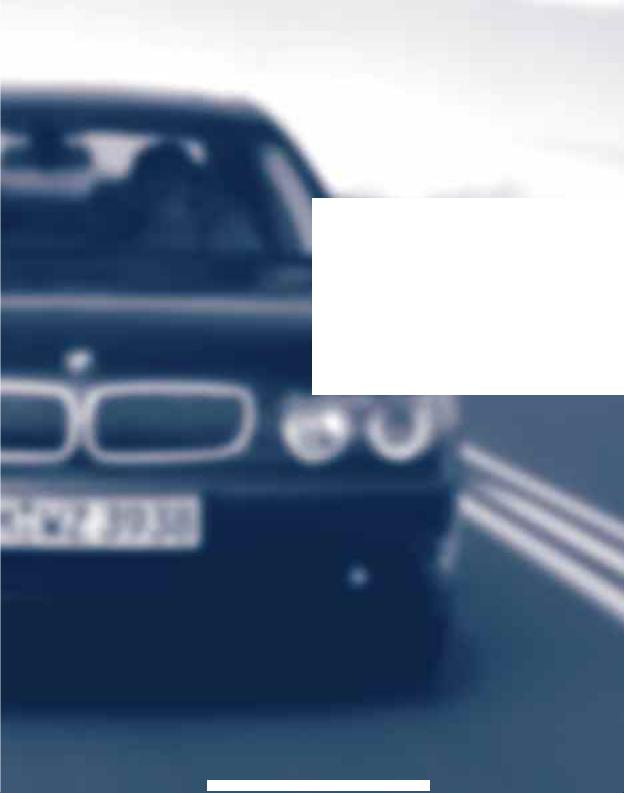
At a glance
This overview of buttons, switches and displays is intended to serve as a source of orientation in your vehicle's operating environment.
The section will also assist you in becoming acquainted with the control concepts and options available for operating the various systems.
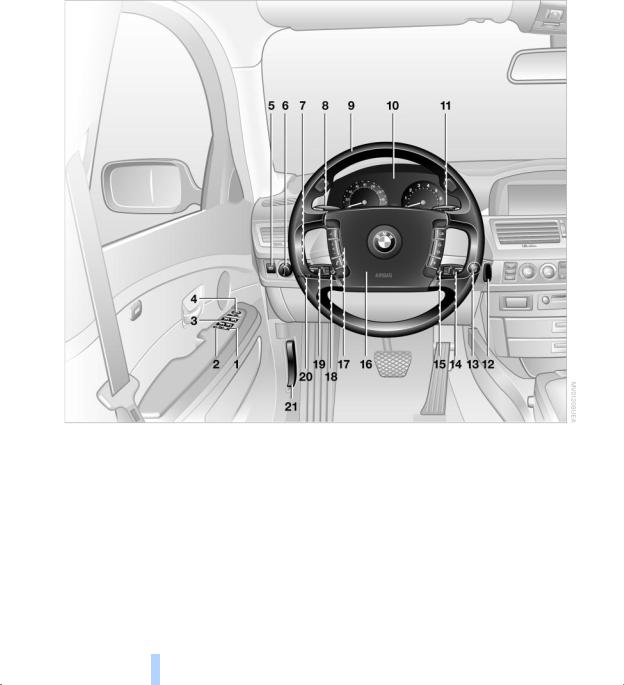
Cockpit
Cockpit
Driver's side – Controls and displays
12
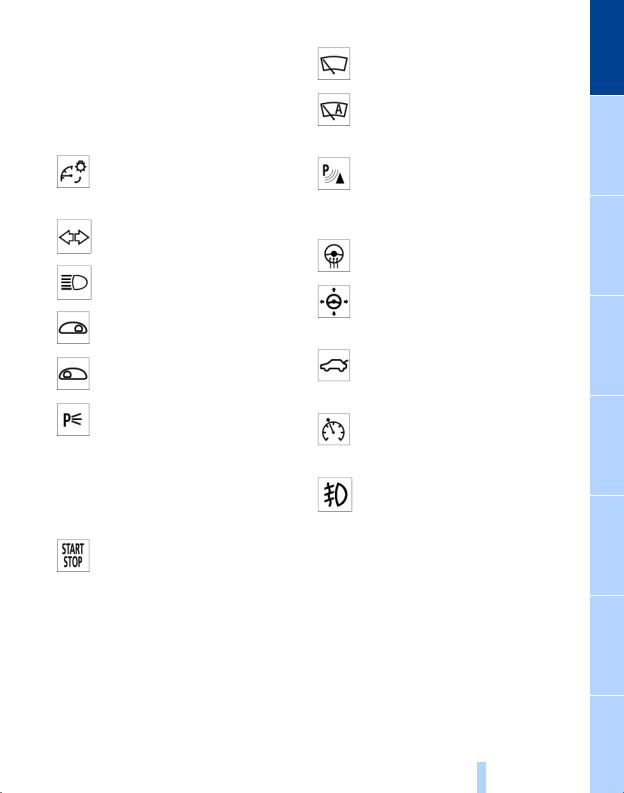
1 |
Rear window sun blind |
109 |
14 |
|
|
|
2 |
Rear window safety switch 42 |
|
Windshield wipers 71 |
|
||
3 |
Electric power windows |
42 |
|
|
|
|
4 |
Exterior mirrors 52 |
|
|
|
Rain sensor 71 |
|
5 |
Parking brake 62 |
|
|
|
|
|
|
|
|
|
|
||
6 |
Parking lamps and low beams |
96 |
|
|
||
7 |
|
|
|
15 |
|
|
|
Instrument lighting |
97 |
|
Park Distance Control (PDC) |
88 |
|
8 |
|
|
|
16 |
Horn: the entire surface |
|
|
Turn signal indicators 71 |
17 |
|
|
||
|
|
|
|
|
Steering wheel heating 53 |
|
|
High beams, headlamp flasher 97 |
|
|
|||
|
|
|
|
|
Steering wheel adjustment 53 |
|
|
Computer 81, |
|
|
|
|
|
|
Check Control |
80 |
|
18 |
|
|
|
|
|
|
|
|
|
|
Computer 81 |
|
|
|
Unlocking the luggage |
|
|
|
|
|
compartment 39 |
|
|
|
|
|
|
|
|
|
|
Standing lamps |
97 |
19 |
|
|
|
|
|
Programmable cruise control |
73 |
|||
|
|
|
|
|
||
9 |
Steering wheel 18 |
|
|
20 |
Front fog lamps 97 |
|
10 Info Display 14 |
|
|
|
|||
|
|
|
Front fog lamps |
|
||
11 Automatic transmission lever |
66 |
|
||||
|
|
|||||
12 Ignition lock 61 |
|
|
|
|
|
|
13 |
|
|
21 |
Opening the hood 175 |
|
|
Switching ignition on and off, starting the engine 62
13
At a glance
Communications Entertainment Navigation Driving tips Controls
Reference Mobility

Cockpit
Info Display
1To view odometer display and reset trip odometer to zero 77
2Speedometer with:
>Display for programmable cruise control 73
>Speed limit display 84
3 Indicator and warning lamps 15
4 Tachometer 77
with navigation system guidance display 132
5 Display panel for
>Computer 81
or
>Check Control text messages 80
or
>Voice command system 26
6 Transmission range selection 66
7 Display panel for
> Automatic transmission program display 66
8 Indicator for
>Outside temperature 77
>Clock 86
or
> Indicator and warning lamps 80
9 Fuel gauge and computer 81
10 Fog lamps 97
14
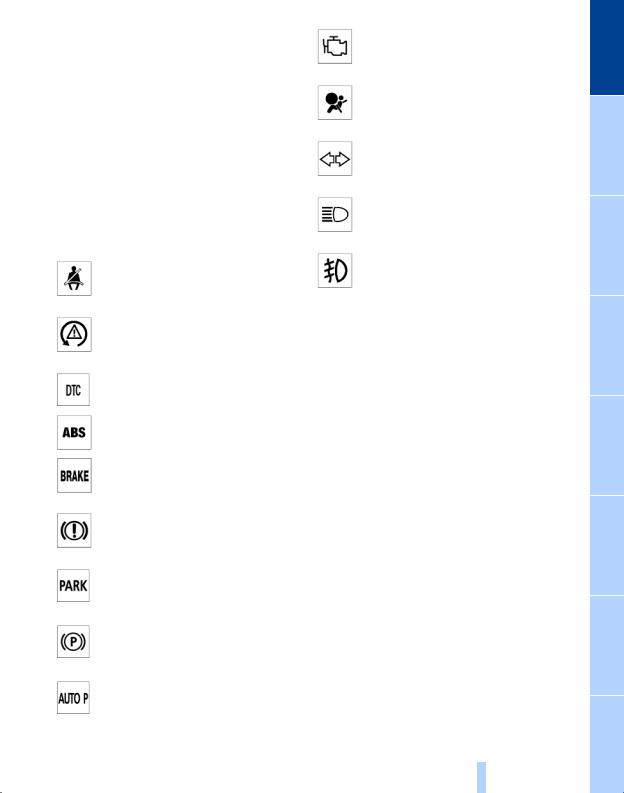
Indicator and warning lamps
Technology that monitors itself
The indicator and warning lamps identified by the ● symbol are subjected to an operation check each time you switch on the ignition or start the engine. They each light up once for different periods of time.
When a malfunction occurs in a monitored system, the corresponding lamp will either fail to go out when the engine is started, or it will come on again during normal driving. For information on how you should respond when this happens, please refer to the pages indicated.
Please fasten safety belts ● 50
DSC Dynamic Stability
Control ● 89
DTC Dynamic Traction Control 89
ABS Antilock Braking System ● 91
Parking brake/Brake system hydraulic circuits/DBC Dynamic Brake Control ● 62/ 91/ 178
Parking brake/Brake hydraulic sytems/DBC Dynamic Brake Control for Canadian models.
Parking brake 62, 65
Parking brake 62, 65
Engine ● 180
Airbags ● 56
Turn signal indicators 71
High beams/headlamp flasher 97
Front fog lamps 97
Colors
The indicator and warning lamps can light up in different colors and combinations. The following section explains the significance of the individual colors as well as how you should respond when they appear.
> Red:
Stop the vehicle immediately or
an important reminder
> Red and yellow:
To drive; drive cautiously
> Yellow:
Have the system inspected at the earliest opportunity
or
for your information
> Green
For your information
> Blue:
For your information.
Automatic parking brake – Automatic Hold ● 63, 65
15
At a glance
Communications Entertainment Navigation Driving tips Controls
Reference Mobility
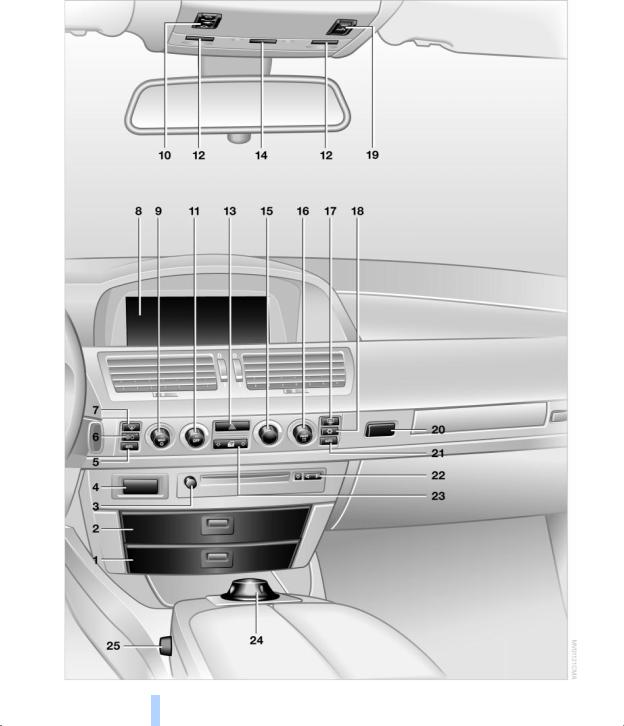
Cockpit
Comfort and convenience – Controls and displays
16

1 Glasses compartment 111
2 Storage compartment 112
3Radio on/off switch and volume adjustment 140, 141
4Key Pad 160
5Automatic air distribution and air supply – left side of interior 100
6Outside air/AUC Automatic recirculatedair control/Recirculated air 101
7To defrost windshield and windows 101
8Control Display 19
9Temperature on left-hand side of passenger compartment – turn and maximum cooling – press 101, 101
10Sliding/tilt sunroof 43
11Air supply on left-hand side of passenger compartment – turn and switch off automatic climate control –
press 101, 103
12Reading lamps 98
13Hazard warning flashers
14Interior lamps 97
15Air supply on right-hand side of passenger compartment 100
16Temperature on right-hand side of passenger compartment – turn and residual heat mode – press 101, 101
17Rear window defroster
18Air conditioning 101
19Trigger emergency SOS call 161
20Open the glove compartment
21Automatic air distribution and air supply, right-hand side of passenger compartment 103
22Station/title search and CD, MD 140
23Central locking system 37
24Controller 19
25Seat adjustment 45
Seat heaters 50
Active seat ventilation 51
BMW active seat 52
Seat, mirror and steering wheel memory 54
17
At a glance
Communications Entertainment Navigation Driving tips Controls
Reference Mobility
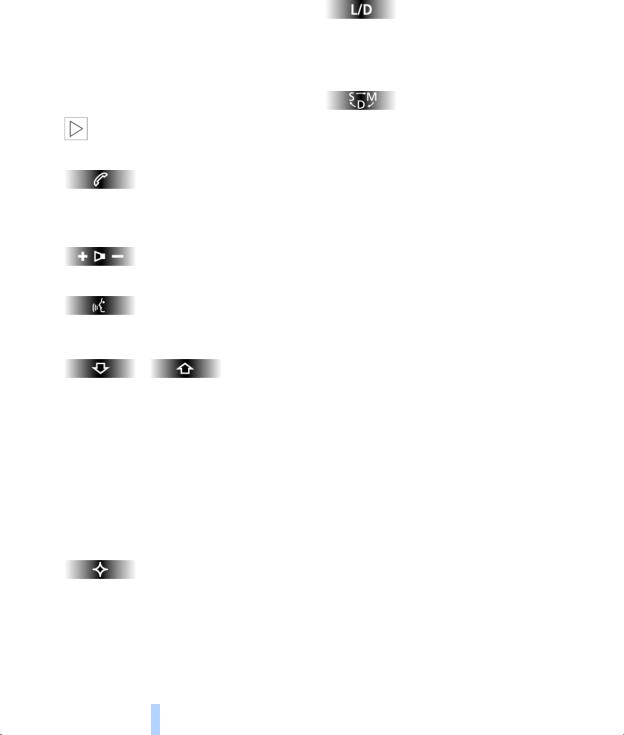
Cockpit
Buttons in steering wheel
Buttons are integrated within the steering wheel to allow convenient control of the following systems, with minimal driver distraction from road and traffic conditions:
>The automatic transmission's L mode
>Selected radio functions
>Selected mobile phone functions
>The voice command system.
The buttons in the steering wheel are only operational when the corre-
sponding systems are switched on.<
Cellular phone:
Receive an incoming call, initiate dialing and end a call
Volume
Voice command system:
To switch on and off
Fast forward/reverse:
> Radio
Press briefly: scans for stations in FM band Extended pressure: Search
> CD/MD
Press briefly: jump to next track Extended pressure: fast forward within track
> Cassette deck
Press briefly: stop track skip or fast forward Extended pressure: fast forward
Available for individual programming: You can program the function for this
button by selecting "MFL" in the "Settings" menu, refer to page 53.
L mode:
Press briefly to alternate between the automatic program and the L mode, refer to page 68.
Steptronic – Canadian models only: Press briefly to proceed through a selection sequence consisting of the automatic program, the Sport program and the manual mode, refer to page 69.
18
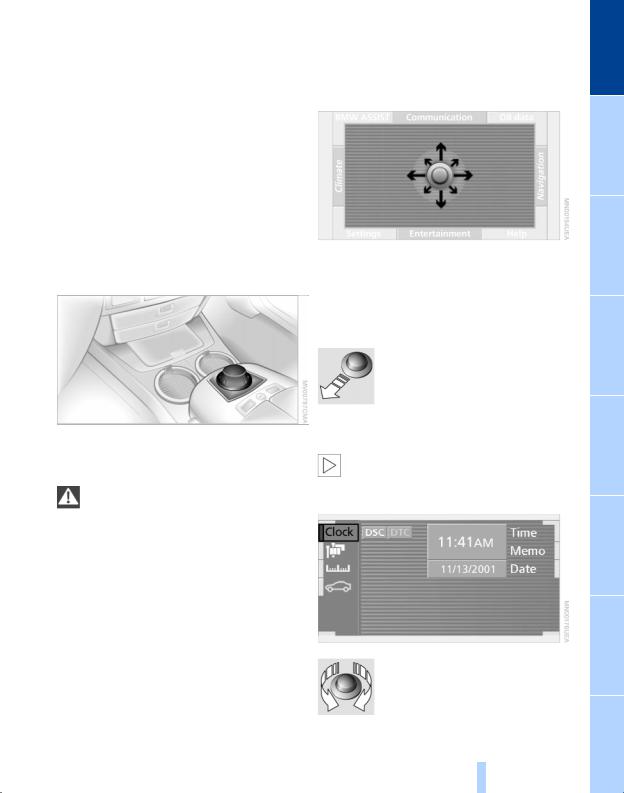
Control Center
The concept |
Control Display |
The Control Center has been designed to avoid the unnecessary complexity created by an extended number of switches and controls. It consists of the controller and the Control Display.
The controller is used to select the functions that will appear in the Control Display. In addition, the Control Display also shows you Check Control messages.
Controller
You can slide, turn and press the controller to enter commands. You can use it for all of the functions in the Control Display.
To avoid posing an unnecessary hazard, both to your own vehicle's
occupants and to other road users: never attempt to use the controls or make adjustments unless traffic and road conditions allow.<
The following introduction illustrates how easy it is to use the Control Center.
You can find detailed instructions describing how to use the individual systems in the separate sections.
An orientation menu is available for selection. Slide the controller
>toward the currently active menu
>twice in one direction.
Select menu
Slide the controller to select a menu – here: "Settings."
The menu appears on the screen as soon as you release the controller.
You can move directly to a different menu by sliding the controller.<
Selecting menu entries
Turn the controller to select the menu entry, here: "Clock."
19
At a glance
Communications Entertainment Navigation Driving tips Controls
Reference Mobility
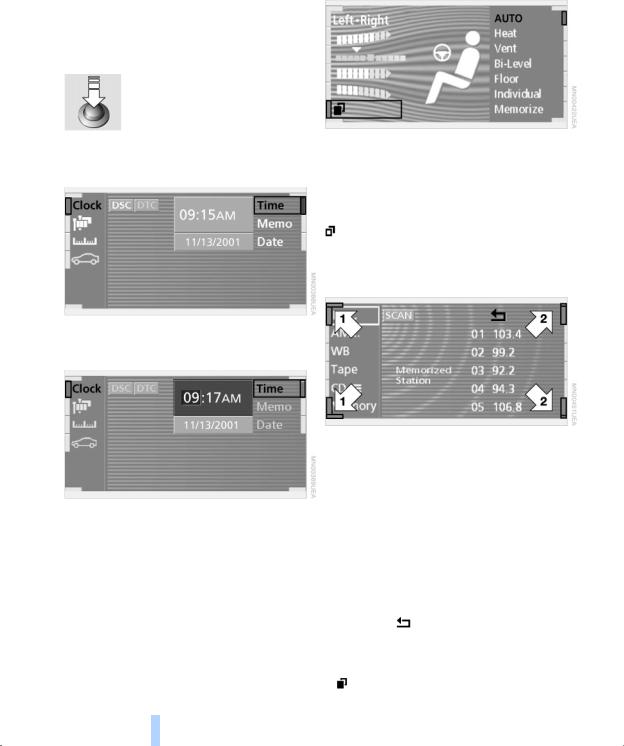
Control Center
Among the available menu entries:
>Adjustment options
>Program
>Function
Confirm selection or entry
Press the controller to confirm the selection, here: "Clock."
Select the desired setting for adjustment from the menu entry, here: "Time" and confirm your entry
Changing menu page
You can select individual pages in specific menus, here: "Climate."
Select the symbol and press the controller:
 To proceed to the second page of the menu
To proceed to the second page of the menu
To return to the first page of the menu.
Symbols and lists
Settings
The first setting option for time is activated.
>Turn the controller to select your setting
>Press the controller to confirm the new setting – store – and to proceed to the next highlighted position to set.
The symbols in the corners and edges of the Control Display have various functions:
1 Corner symbols:
Select these symbols to proceed to the opposite page of the menu.
To change page: turn the controller
2 List symbols:
Indicates that you can only move within the same page of the menu. You are currently in a list, for instance, stored radio stations. Turn the controller to select an entry from
the list. |
|
Select the |
symbol and confirm your |
selection to exit from the list.
Symbols
To proceed to the second page
20
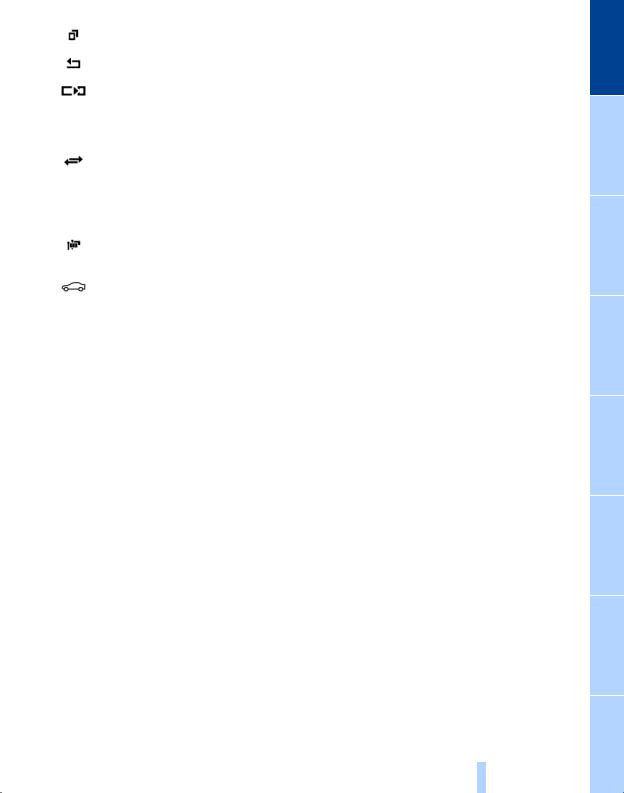
To return to the first page
To exit from the list
To transfer the current display to the assistance window. For more detailed information on the assistance window, refer to page 24
To transmit vehicle data to the BMW Service Center – in preparation
 For information on display units and formats, refer to page 86
For information on display units and formats, refer to page 86
Selecting language for text displays, refer to page 86
Selecting settings for vehicle functions
21
At a glance
Communications Entertainment Navigation Driving tips Controls
Reference Mobility
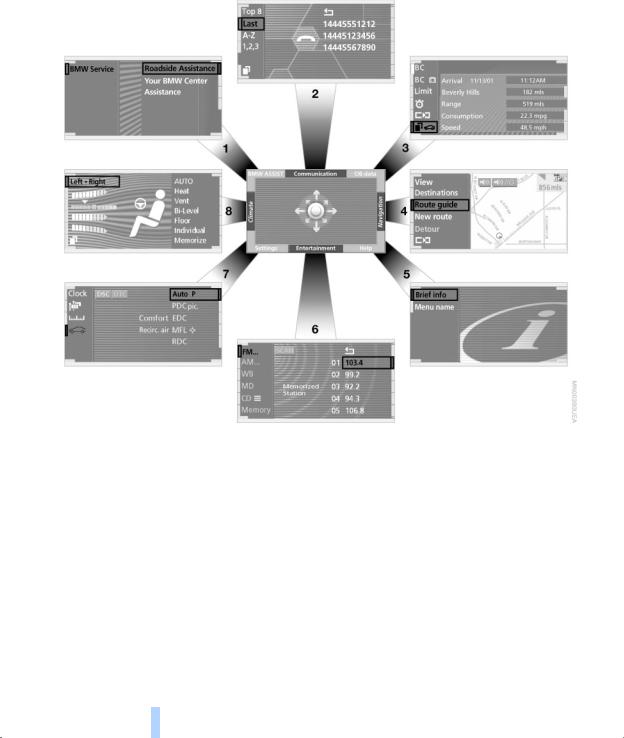
Control Center
Menus in Control Display
You can select from an extended range of functions and setting options:
1BMW ASSIST – refer to the separate manual
2Communications
>Using the mobile phone 158
>Cellular phone, refer to separate Owner's manual
3 OB data
>Computer 81
>Limit 84
>Stopwatch 85
>Service Interval Display 78
>To access Check Control messages 80
4 Navigation 124
5 Help
>Brief "help" text displays 24
>Menu name for menu change
6Entertainment > Radio 143
> Cassette 153 > CD 146, 148 > MD 151
7Settings
>Time and date 86
>Language 86
>Units of measure and display format 86
8 Climate
>Automatic climate control 99
>Seat heating 50
>Parked-car ventilation system 106
22
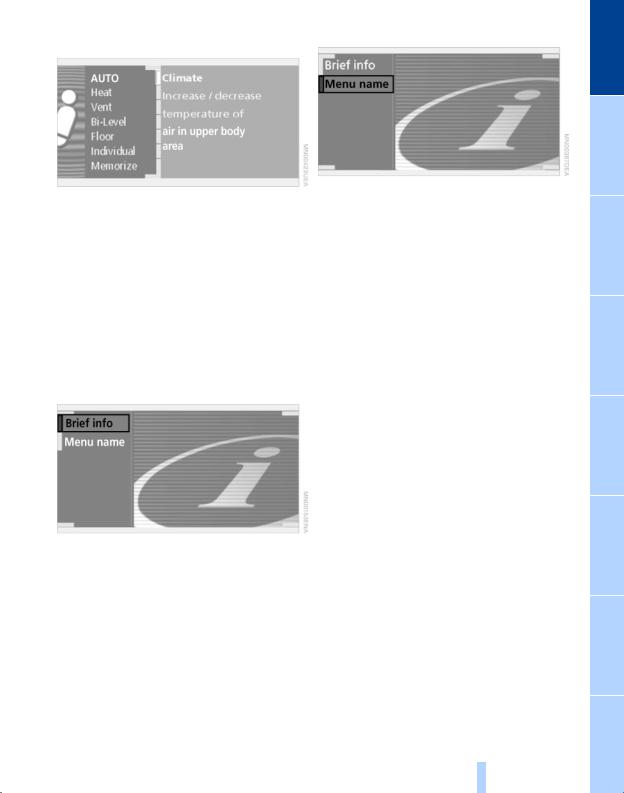
Assistance window* |
To activate menu name |
While you use the Control Center the assistance window can provide you with a parallel display for the active system.
You can use it for displays of the following:
>Short "help" and supplementary information texts for selected menu entries
>A function selected from the "OB data" menu, refer to page 85
>The travel route on vehicles equipped with a navigation system, refer to
page 132.
Help texts in assistance window
You can call up and also cancel displays containing "help" and supplementary information texts on selected menu entries in the assistance window.
1.Select "Help" from the orientation menu
2.Select "Brief info" menu and confirm. The "help" texts appear in the assistance window
3.Confirm again to deactivate the automatic display.
You can program the system to display the menu name each time you proceed to a new menu.
1.Select "Help" from the orientation menu
2.Select "Menu name" and confirm your entry.
23
At a glance
Communications Entertainment Navigation Driving tips Controls
Reference Mobility
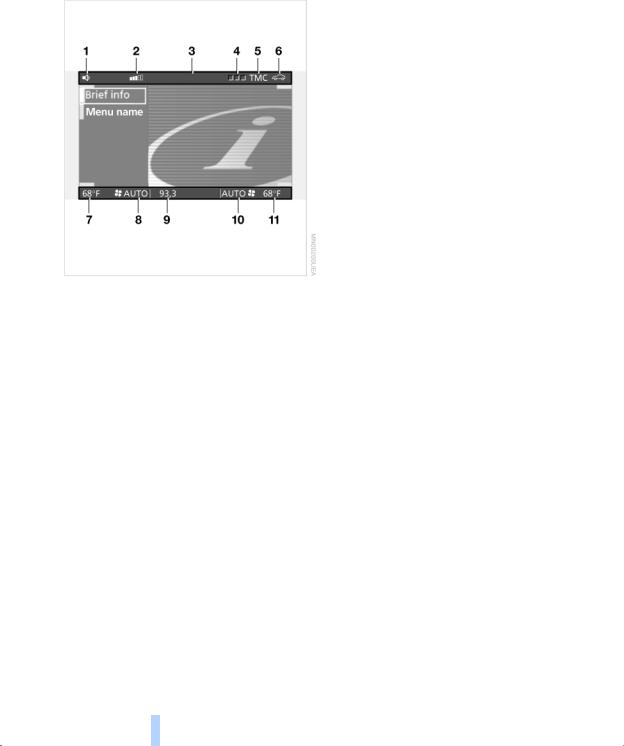
Control Center
Top and bottom status lines |
9 Entertainment – display for radio, |
|
cassette, CD, MD |
|
10 Air supply, right-hand side of passenger |
|
compartment |
|
11 Temperature selection display, right- |
|
hand side of passenger compartment. |
|
Assistance window |
|
The status lines in the assistance window |
|
show the following: |
|
> Outside temperature |
|
> Navigation system destination |
|
> Time |
|
> Date. |
1Hands-free mode active
2Mobile phone reception strength
3Display for phone service provider
4Mobile phone status
>Green: incoming or outgoing call
>Red: no network available
>Yellow: routed through alternate service network – Roaming
5Traffic Message Channel activated – in preparation
6Status Check Control 80
>Green: no message
>Yellow: priority 2 – the symbol flashes briefly. You can use the "OB data" menu to have the status report shown in the Control Display
>Red: priority 1 – these messages appear immediately, accompanied by a gong and a flashing symbol
Status Service Interval Display 78
> Red: at least one service interval has been exceeded
7Temperature selection display, left-hand side of passenger compartment
8Air supply, left-hand side of passenger compartment
24
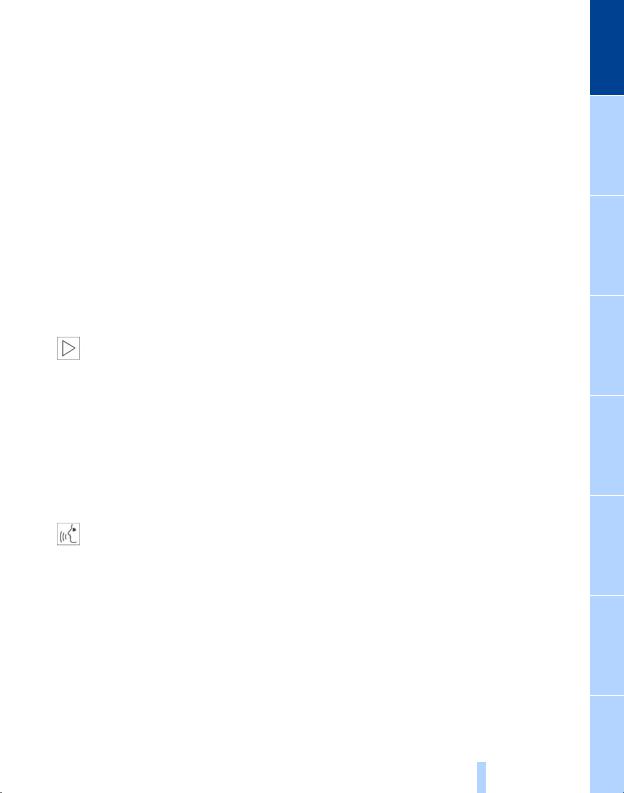
Voice command
Voice command system*
The concept
The voice command system allows you to control operation of various vehicle systems without ever removing your hands from the steering wheel. The system operates on the basis of voice commands that you will learn easily after using them a few times. You issue your commands in the form of instructions or in dialogs. The dialog functions provide you with additional support in the form of questions and information.
The voice command system transforms your commands and dialog answers into control signals for the selected systems.
Please take the time to acquaint yourself with how a particular system
operates before proceeding to control it using the voice command system. At the time of publication the voice command system was available for use with the English and German languages. Other languages are currently in preparation. When the voice command system is active you can adjust the volume, refer to
page 141.<
Symbols used
indicates control via the voice command system.<
>>...<< identifies commands used in the voice command system. It is not necessary to speak the words in parentheses.
>...< identifies the answers provided by the voice command system.
>Radio, refer to page 140 >>Radio (menu)<<
>CD, refer to page 146 >>CD (menu)<<
>CD changer, refer to page 148 >>CD changer (menu)<<
>MiniDisc, refer to page 151 >>MiniDisc (menu)<<
>Cassette, refer to page 153 >>Tape (menu)<<
>Notebook, refer to page 28 >>Notepad (menu)<< or >>Notebook (menu)<< or >>Note recorder (menu)<<
Either the system that you are now controlling, or any current error messages will appear in the Info Display, refer to page 14.
Voice commands
To activate voice command system
Activate by briefly pressing the button  in the steering wheel.
in the steering wheel.
A signal tone and "SVS" in the Info Display indicate that the system is ready for use. You automatically proceed to the orientation menu.
Except in dialogs, always press
the  button again before issuing voice commands.
button again before issuing voice commands.
During dialogs that include entry of text or numbers, the information that the voice command system has registered will appear on the Info Display screen, refer to page 14.
Systems available for use with voice command
>Mobile phone, refer to page 158 >>Telephone (menu)<<
>Navigation system, refer to page 124 >>Navigation (menu)<< or
>>Navi (menu)<<
To cancel voice command entry
You can terminate execution of a command or dialog with >>Cancel<<, >>Exit<< or by pressing the  button in the steering wheel.
button in the steering wheel.
25
At a glance
Communications Entertainment Navigation Driving tips Controls
Reference Mobility
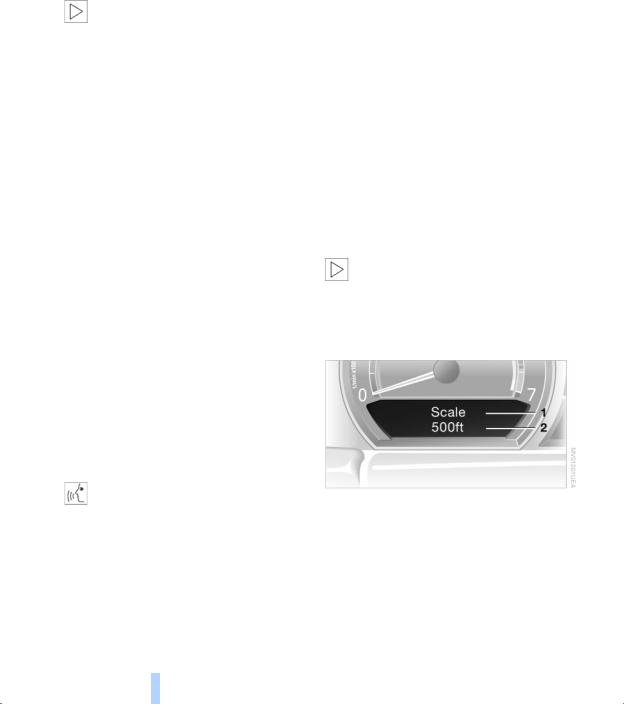
Voice command
The  button must be used to terminate unrestricted, open dialogs in which any text might occur, such as those containing names, notes, etc.
button must be used to terminate unrestricted, open dialogs in which any text might occur, such as those containing names, notes, etc.
The system automatically switches over to its telephone mode if you
receive a call during a dialog. The system issues the voice message >Cancelled< and "PROCESS TERMINATED" appears in the Info Display, see Status displays below.<
Voice commands
The voice command system operates on the basis of specific, predefined commands; these commands should be spoken precisely as indicated. You can listen to a selection from the command list by activating the system, refer to page 26 and issuing the command >>Options<< or >>What now<<.
The voice command system also features an entry-level >>Main menu<< that allows you to select individual accessories, refer to page 26.
Brief commands
At the >>Main menu<< level you can use "brief commands," refer to page 30 to initiate direct execution of selected functions without first proceeding to the "systems" level.
Special commands
Special commands are available for specific systems. In this Owner's Manual you will find these commands in the sections describing the individual systems.
Instructions for using the voice command system are always identi-
fied by this pictogram.<
Standard commands
The standard commands available for use with all controlled systems are:
> >>Pardon<< or >>Repeat<< Repeats the last message issued by the voice command system
>>>Cancel<< or >>Exit<< Terminates the voice command system
>>>Standard dialog<<
or >>Extended dialog<< Comprehensive instructions and error reports guide you through the system
> >>Short dialog<<
In this setting your guidance through the system is provided exclusively in the form of brief statements
> >>Help<<
Allows you to request information on various systems
>>>Options<< or >>What now<< Provides you with a listing of the commands available for the selected system. A corresponding list simultaneously appears in the Info Display, see Status displays below
>>>Main menu<<
Provides access to submenus.
To make it easier for you to become acquainted with the system, it is
preset to the >>Standard dialog<< or >>Extended dialog<< mode at the factory.<
Status displays
The Info Display shows you what the voice command system has understood in line 2, while also indicating which voice command or question is currently active in line 1.
Any current error messages will also appear in the display panel.
26
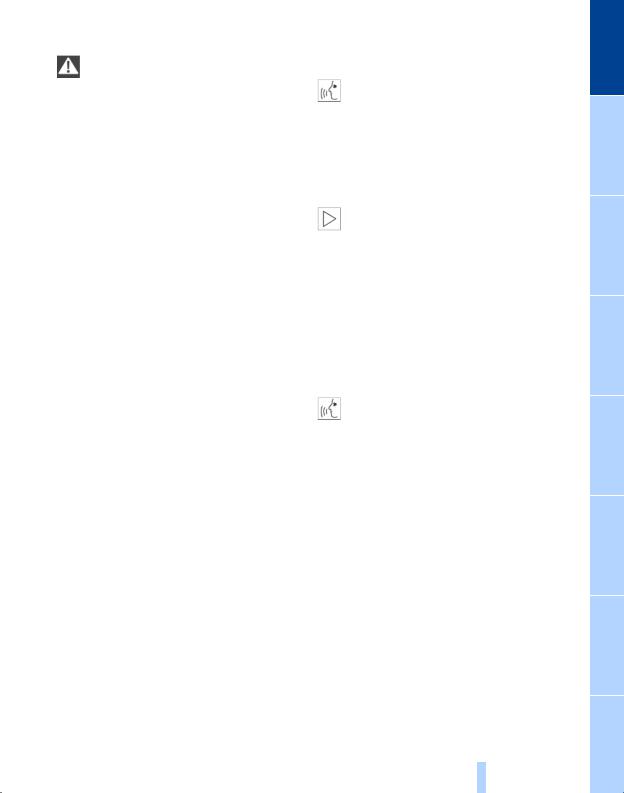
Notices
Do not use the voice command system to make emergency SOS
calls. Your voice and habitual tone could be affected by stressful situations, as a result of which the process of establishing the telephone connection could be unnecessarily delayed. Instead, you should use the emergency SOS button located adjacent to the rearview mirror, refer to page 161.<
Environmental conditions
The voice command system uses a special microphone located on the front headliner of your vehicle. Although the system is designed to filter out ambient noise, you can help ensure that your commands will be understood by observing the following instructions:
>Speak smoothly and clearly, at a normal volume. Do not place any unusual stress on individual syllables, and avoid pauses
>Do not speak while the voice command system is talking
>Keep the doors, windows and sunroof closed to prevent interference from ambient noise
>Avoid other sources of noise in the vehicle while speaking, and ask other vehicle occupants to refrain from talking while you are using the system.
>The hands-free microphone is aimed toward the driver. This means that the system may be unable to register the voices of other vehicle occupants properly; passengers should use the mobile phone instead.
The notebook
Recording a note
>>Record note<<<
You can store approx. ten minutes of spoken text – either as a single entry or as multiple entries of any desired length.
To terminate recording:
Apply extended pressure to the  button.
button.
The voice command system does not respond to the commands
>>Cancel<< and >>Exit<< while you are recording a note. The standard utility that scans for system commands is deactivated in the note mode to allow you to record any text desired, without artificial restrictions. This feature saves you from having to concentrate on avoiding these words while recording.<
To listen to a notebook entry
Listening to recorded notebook entries:
1. >>Read out (note)<< or >>Listen to (note)<<
The system plays back roughly the first 3 seconds of the first memorandum.
2. Respond to the query >Note and then< by selecting the desired function
> To listen to the entire note:
>>Read (note)<< (>>Listen to (note)<<)
>To hear the next notebook entry: >>Next note<< (>>(Note) next<<)
>To hear the entry again: >>(Note) back<<
or
>>Once again<< (>>Repeat<<, >>Read out<<).<
27
At a glance
Communications Entertainment Navigation Driving tips Controls
Reference Mobility

Voice command
To delete notes
1.>>Edit (note)<<
2.>>Delete (current note)<<.<
Clearing the notebook
> To delete all contents from the notebook:
>>Delete (note pad)<< (>>Delete (notebook)<<, >>Delete (note
recorder)<<)<
28

Brief commands
Function |
Command |
||
To switch on mobile |
>>Telephone on<< |
||
phone |
|
|
|
Redialing |
>>Redial<< |
||
To select from the |
>>Dial name<< |
||
phone directory |
|
|
|
Dial telephone |
>>Dial (telephone) number<< |
||
number |
|
|
|
To add new entry |
>>Save name<< |
||
To display the entry |
>>Read out telephone book<< |
||
Delete entry |
>>Edit telephone book<< |
||
To deactivate voice |
>>Message (output) off<< |
||
messages from |
|
|
|
system |
|
|
|
To activate voice |
>>Message (output) on<< |
||
messages from |
|
|
|
system |
|
|
|
To repeat previous |
>>Repeat message (output)<< |
||
navigation guid- |
|
|
|
ance instructions |
|
|
|
Destination entry |
>>(Navigation) destination entry<< |
||
submenu |
|
|
|
Select destination |
>>Select destination<< |
||
To change scale |
>>(Change) scale<< |
||
Starting the desti- |
>>Route guidance (on)<< |
||
nation guidance |
|
|
|
system |
|
|
|
You are searching |
>>(Navigation) information<< |
||
for a destination, |
|
|
|
but do not know the |
|
|
|
exact address |
|
|
|
To request |
>>(Navigation) address book<< |
||
addresses |
|
|
|
Map display |
>>Map<< |
||
To switch off audio |
>>Audio off<< |
||
source |
|
|
|
To switch on radio |
>>Radio on<< |
||
Selecting radio |
>>(Radio) frequency selection<<, >>Frequence selection<<, |
||
stations |
>>Frequency input<< |
||
|
29 |
|
|
|
|
|
|
|
|
|
|
At a glance
Communications Entertainment Navigation Driving tips Controls
Reference Mobility
